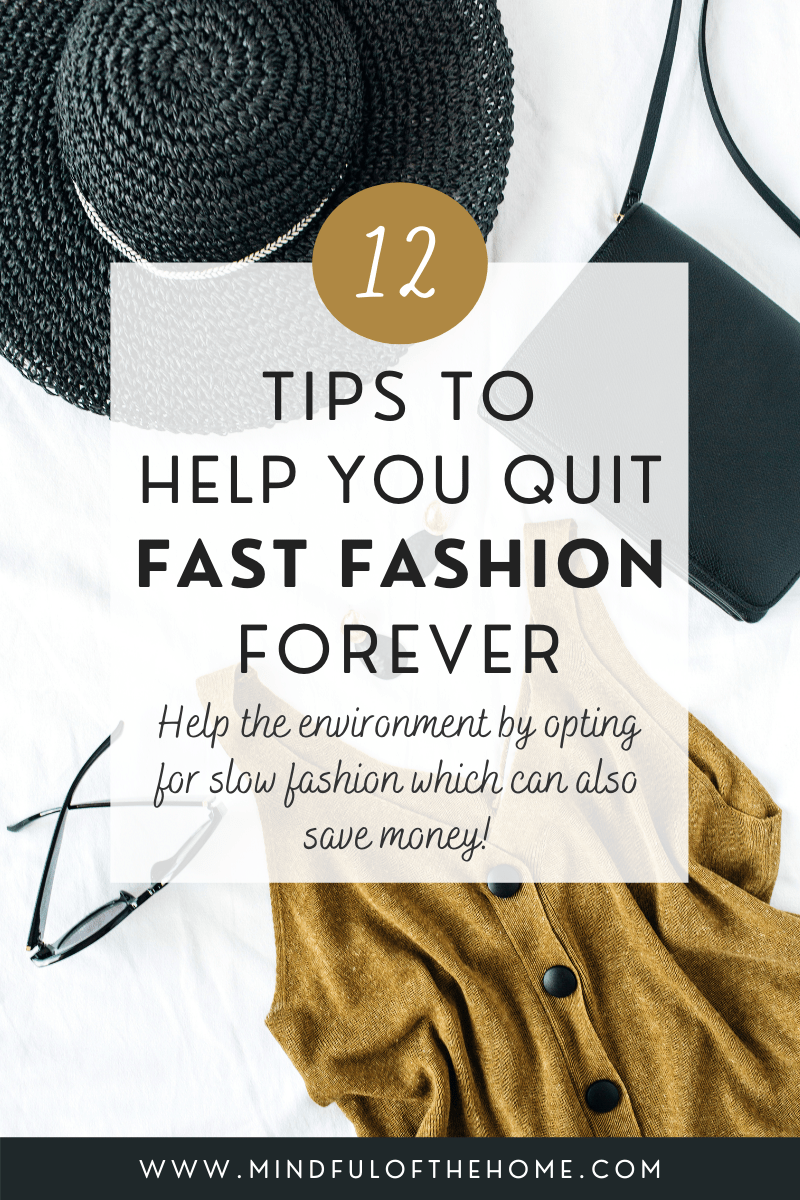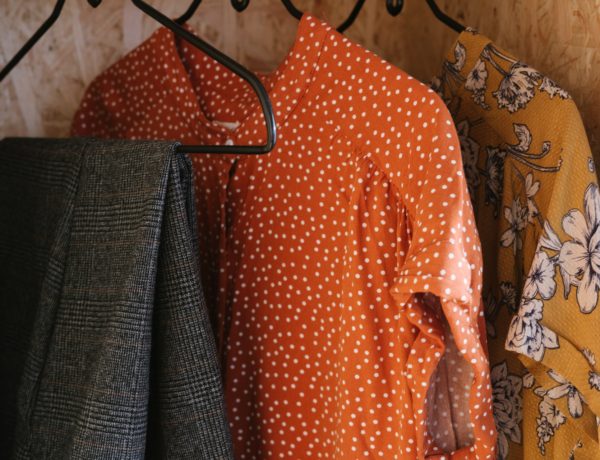One of the best things you can do for the planet is to quit fast fashion, but how do you go about it when fast-fashion prices are so temptingly low? Thankfully, there are a bunch of different ways to say goodbye to fast fashion once and for all, and that won’t cost you an arm and a leg.
By staying away from fast fashion brands and practicing slow fashion instead, you’ll have a quality wardrobe that didn’t cost a fortune and that’s more sustainable and ethical.
By the end of this post, you’ll have all the information you need to stop buying fast fashion so you can start building a more sustainable wardrobe.
Fast Fashion Meaning
Fast fashion typically means that the clothing was rapidly produced to stay up to date with the latest trends, that’s manufactured using cheap inexpensive materials like polyester and made by people who aren’t being paid fairly.
And what’s sad is that some of the most popular fashion brands out there are fast fashion brands. That’s a lot of environmental and social harm being done for the sake of a new on-trend outfit.
So what can we buy instead of fast fashion? And how do we stop supporting these fast-fashion retailers that are polluting the earth and aren’t ethical? These easy tips will help you out!
This post contains affiliate links which means I may receive a commission at no extra cost to you should you click through and make a purchase.
How to Quit Fast Fashion
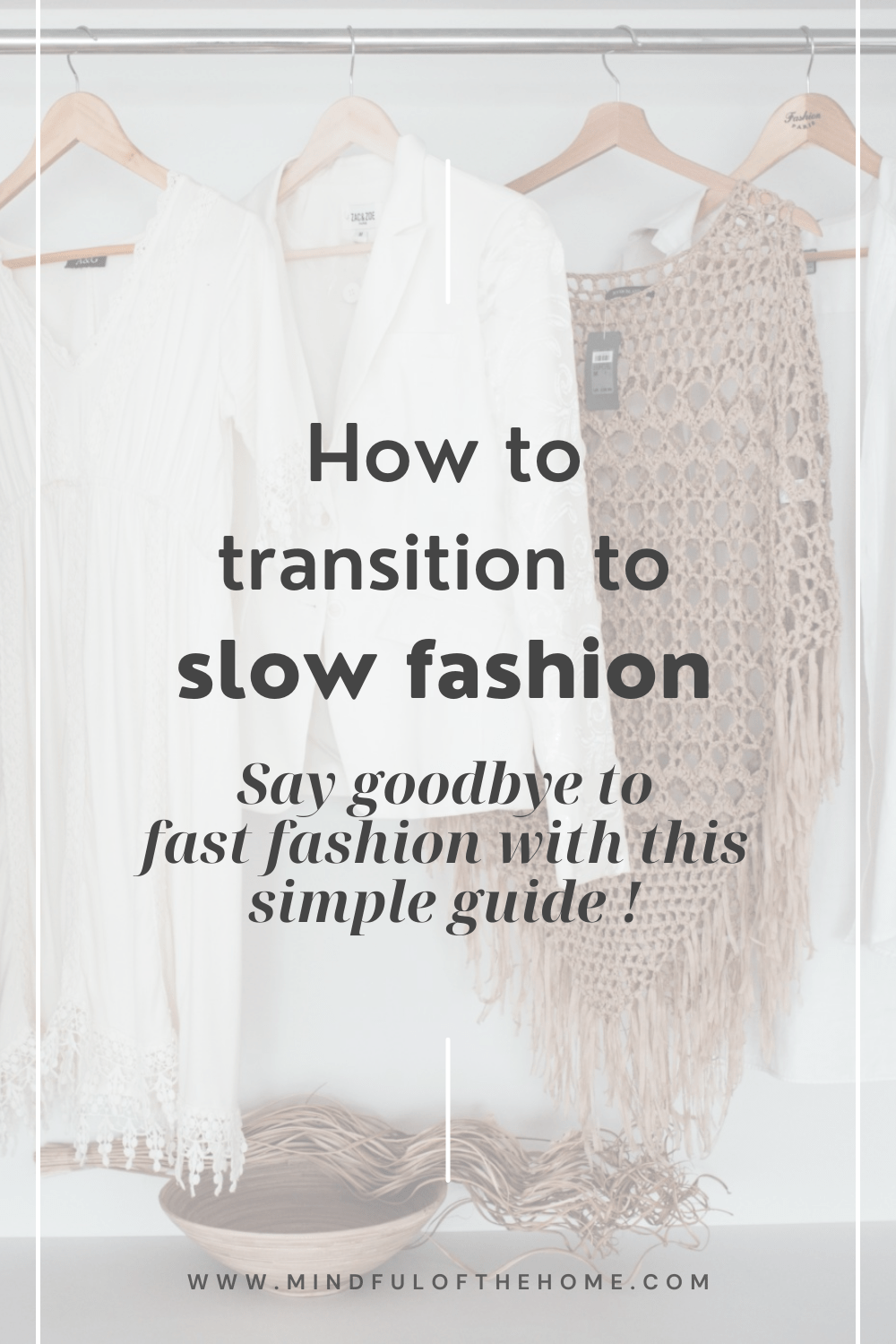
1. Discover your why
The first step to quitting fast fashion is discovering your reason why, or in other words, discovering your main motivator for ditching fast fashion.
Do you want to save money? Do you want to help the environment? Do you want to have clothes that simply last longer? Do you want ethical fashion made with sustainable materials, that was also made by people who were fairly paid?
Having your why is an important thing to help you stay motivated to practice slow fashion and stay away from fast fashion trends. Keep your reason in mind throughout the post as certain tips will have more appeal to you, depending on your ‘why’.
2. Educate yourself on the cons of quick fashion
If you’re reading this post, chancing are you probably already know about the cost fast fashion has on the environment. But if you don’t, here are some brief statistics to enlighten you to help you fight fast fashion. If you’re unsure of what your why might be, these stats may help you determine that!
- Many fast fashion brands don’t pay fair wages to workers, have poor working conditions or even use child labor.
- Fast fashion contributes to 10% of humanity’s carbon emissions.
- 85% of textiles just end up in landfills.
- 35% of microplastics in the ocean come from synthetic fabrics like polyester.
- It takes about 700 gallons of water to produce just one cotton shirt. (Enough water for someone to drink 8 cups a day for over 3 years.)
- For jeans it’s 2,000 gallons or 8 cups of water a day for 10 years.
- Textile dyes are the world’s second-largest polluter of water because that water is usually just dumped into streams and rivers.
- Fast fashion is the cause of 20% of water pollution worldwide.
- Washing clothes releases 50 billion plastic bottles worth of microfibers into the ocean each year.
Knowing these environmental issues is a crucial step when fighting against fast fashion because you can think of these reasons whenever you feel tempted to purchase unsustainable clothing.
SOURCE: these facts show how unsustainable the fashion industry is.
3. Stay away from fast fashion stores
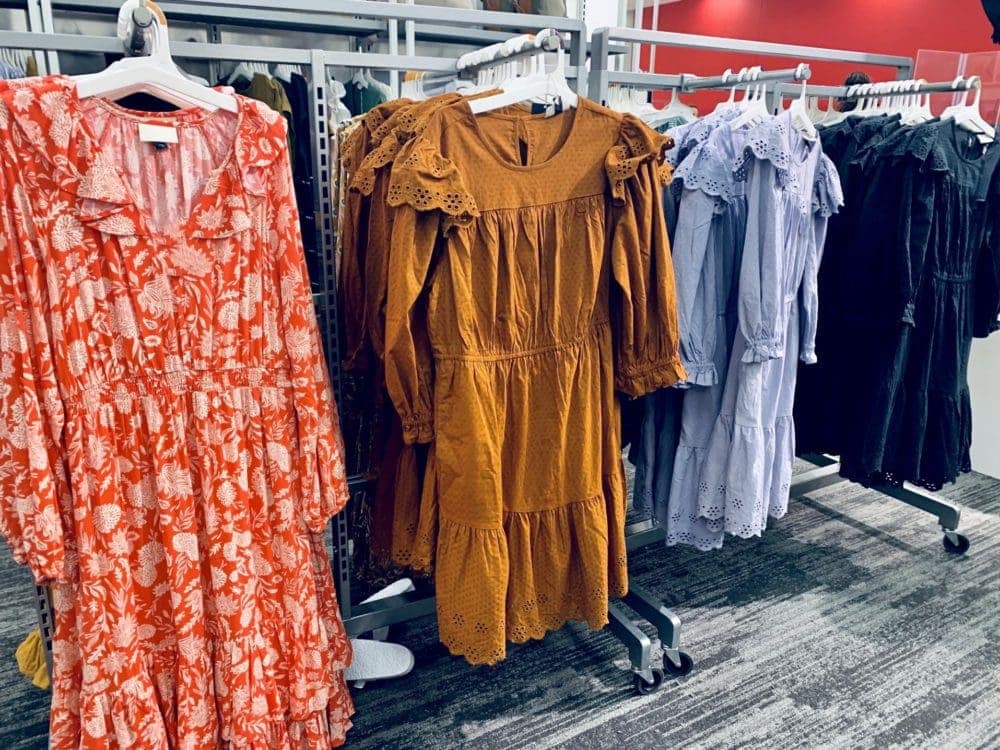
The best way to stop wearing fast fashion is to stop buying it and therefore steering clear of temptation by not stepping foot in their stores. That also includes unsubscribing from their email newsletters.
As a conscious shopper, you want to avoid temptation, and fast fashion brands are all about tempting you with their cheap prices.
Do not go to stores like Urban Outfitters. Don’t download apps like Shein. Don’t let fast fashion’s cheap prices tempt you!
Some more fast fashion brands to avoid are Zara, Fashion Nova, Forever 21, Wish, Zaful, Nasty Gal, Target, and Wal-Mart.
A thing to remember is if it’s cheap and it’s not on sale, it’s fast fashion.
4. Understand that fast fashion is NOT cheaper
A great way to stop buying fast fashion is to understand that it’s not cheaper.
The thing with fast fashion is that the upfront cost is incredibly cheap and therefore hard to pass up. However, fast fashion is also cheaply made. The garment won’t last long, and you’ll end up wasting your money.
Would you rather pay $10 for a shirt that will last a couple of months or $30 for a shirt that will last you a couple of years?
With conscious fashion, you may pay a little more money upfront for a new outfit, but it won’t deteriorate after a couple of washes. Instead, it will last you years and years.
So if you’re someone who loves buying new clothes, be willing to pay more money upfront. If you want to stick with secondhand clothing which is more affordable, skip the next point and head to #6.
5. Choose slow fashion brands
If your ‘why’ for wanting to quit fast fashion is mainly based on wanting to have quality clothing that will last longer, consider shopping from ethical brands instead, like tentree.
Subscribe to sustainable brands’ emails, follow their Instagram, etc. to stay updated on them and to be informed of the products they’re selling as well as their sales. Everybody loves a great deal.
Sustainable fashion brands may use sustainable fabrics, have ethical manufacturing, or may even be certified fair trade. If you’re unsure, you can always do a little bit of research on the brand and ask questions prior to making a purchase to see if the company is an ethical clothing brand.
You can also do a quick search on the Good on You Directory to see their sustainability rating.
Having more brands practice sustainability in regards to their fashion lines is the only way to end fast fashion once and for all. It may be a long time before that happens, but we can all do our part to help speed up the process!
6. Shop secondhand
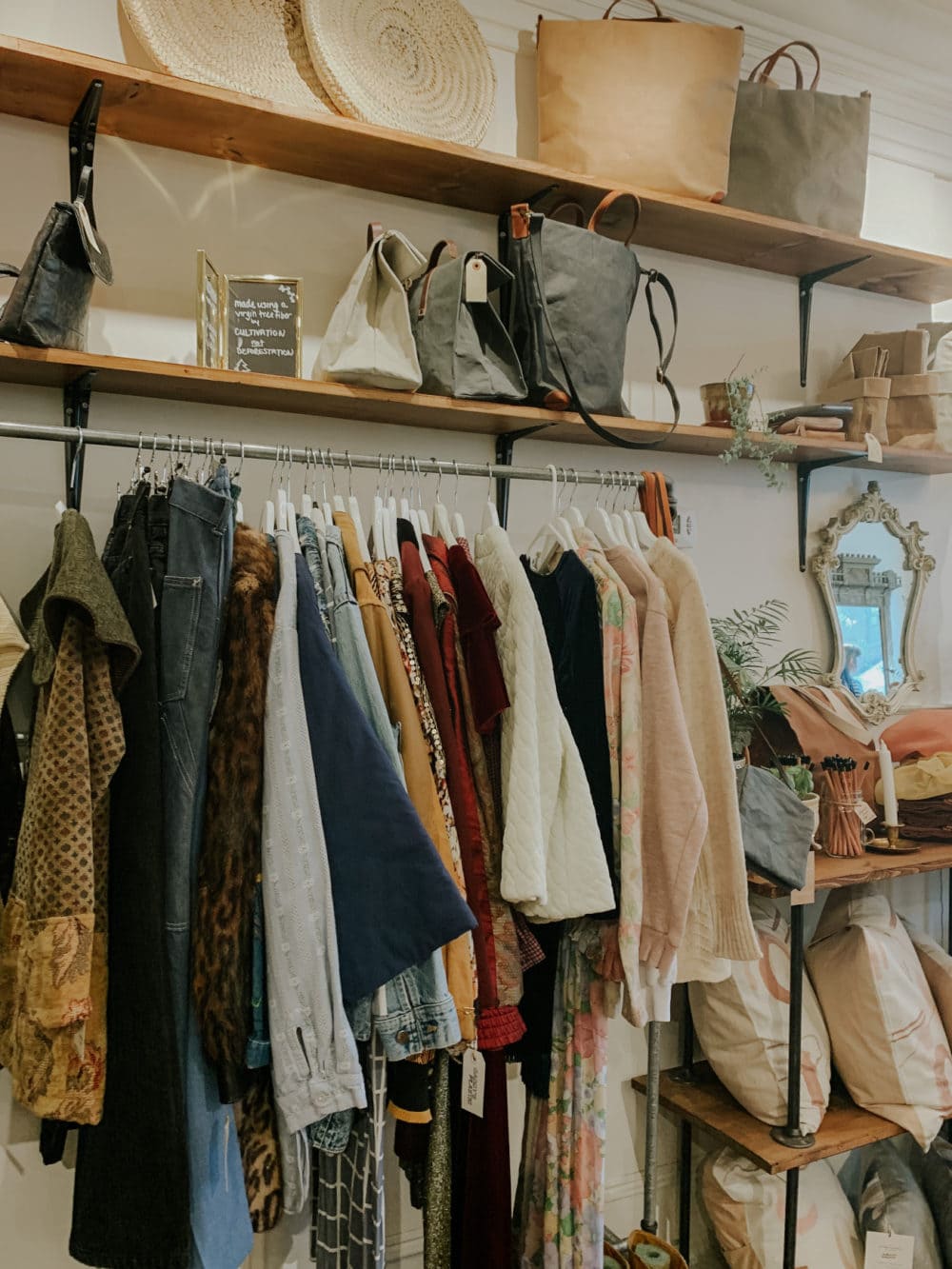
If you want to stop buying fast fashion and wondering what to buy instead, but you want it to be as cheap in price as fast fashion, start thrifting clothes! This is easily the best way to quit fast fashion once and for all.
I feel like I mention the benefits of thrifting clothing in every post where I talk about sustainable fashion, but it’s literally the easiest way to practice slow fashion without breaking the bank and the best alternative to fast fashion.
You get the thrill of a deal that fast fashion gives you, but it’s super environmentally friendly. That’s because buying secondhand clothing helps keep clothes out of landfills, and it replaces the need for another garment to be created, fast or not.
READ MORE: Why Buying Secondhand Clothing is Awesome
So if you’re on a budget, but want to ditch fast fashion, start thrifting clothes! I highly recommend Poshmark, (especially if you’re Canadian since Poshmark has the least expensive shipping rates compared to other online thrift stores.) You can also find new items that still have the tags on them being sold on Poshmark.
Check out Poshmark and sign up with my code MINDFULHOME to save $15 on your first order!
POSHMARK quick tips: search for clothing via categories and filter it for your price point. When you find something you like, check out the seller’s closet and filter by your size, available, and sort by price. Buy various items from one Posher to save on shipping costs!
7. Buy fewer clothes

Another solution to fast fashion is to slow down and buy less clothing in general. Since fast fashion also means going through clothing quickly, a way to avoid that is to change our shopping habits and simply shop less.
This is one of the reasons why capsule wardrobes are so popular. YA capsule wardrobe includes a few of each type of item (shirts, sweaters, shorts, pants, etc.) that are high in quality and pair well with each other.
This way you have less clothing, but they mix and match so well that you get multiple outfits.
When you’re shopping for new additions to your sustainable wardrobe, whether it be secondhand or new, ask yourself if the sweater, cardigan, tank top, etc. matches MULTIPLE items.
The last thing you want to do is buy a shirt that only goes well with one pair of pants. This is a great way to be a conscious consumer in regards to your clothing and also makes creating your outfits a lot easier.
8. Wash with care

An extremely important part of having sustainable clothes is to ensure you take care of everything you own.
Buying a new garment and it getting ruined in the wash due to not knowing its washing instructions will turn a slow piece of clothing into a fast one.
You want your clothes to last a long time, and the simplest way to do that is to read the washing instructions tag on the garment since it usually tells you everything you need to know and follow them.
Here are some more tips on how to make sure your clothes last longer.
9. Clean out your closet to find forgotten clothes
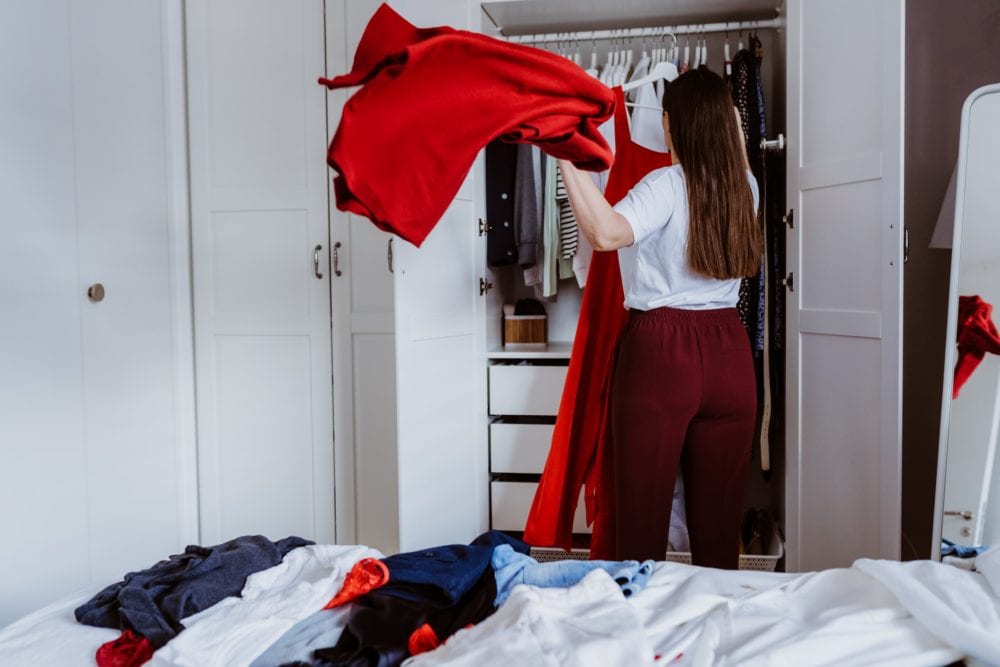
An easy way to say goodbye to quick fashion is to wear the clothes that you already have.
Fast clothing isn’t only based on the type of materials used to make the garment. It also has to do with how often it gets worn.
Check out your closet to see if there are any old clothes that you have forgotten about but still love, and rotate them into your outfits if you can. You may even discover a sweater or shirt that you loved but completely forgot about!
10. Keep track of what you never wear
After going through your current wardrobe, note what you never wear and don’t think you will wear again.
Do you have clothes that have spent more time in your closet than they have on you? Is it because the color doesn’t match or you don’t like the style anymore, or does a certain material make you uncomfortable?
Knowing what not to buy in the future is an important step when quitting fast fashion because it will help you stay away from fast fashion habits.
Figure out the reasons why you don’t wear certain pieces of clothing and avoid buying things that are similar.
11. Keep some damaged clothes
Everyone should have some clothing that they can wear when doing a task or a hobby that may be dirty like cleaning, gardening, painting, etc.
These are instances where having clothes that are already stained or have a hole is ideal. You wouldn’t want to accidentally ruin a perfectly good piece of clothing.
Instead of buying clothes to use for such activities, or throwing away a piece of clothing because it has a hole or a stain, consider keeping it for dirty tasks.
12. Sell your unused clothing

All the unused clothing you have sitting in your closet isn’t benefitting anyone. But you can benefit your wallet and the environment by selling them to thrifters.
Unless the piece of clothing is severely damaged, the chances are really high that someone else would wear it, instead of it just cluttering your wardrobe.
The fast-fashion option would be to simply throw your unworn clothing away, but instead, you should give away or sell items that are still in good shape. Sell your clothes in your local area through buy and sell Facebook groups, or sell your items on Poshmark!
Final thoughts on quitting fast fashion
As you can see, there are many solutions to combat the fast fashion industry that are super easy to do and are budget-friendly. I hope this has inspired you to take action!
Which tip are you going to implement into your lifestyle in order to lower your environmental impact? Leave a comment below!
